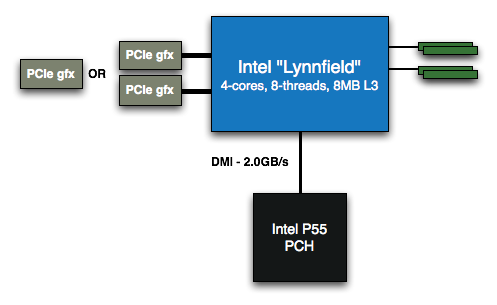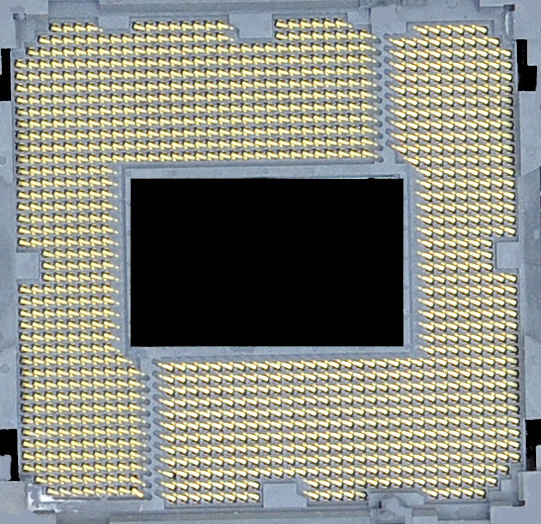The Lynnfield Preview: Rumblings of Revenge
by Anand Lal Shimpi on May 29, 2009 1:00 PM EST- Posted in
- CPUs
Making Nehalem Affordable: LGA-1156
Take the Core i7, shave off one memory controller and replace the high bandwidth QPI link with Intel’s slower DMI and you’ve got the makings of a (more) mainstream Nehalem.
Many have been calling this processor the Core i5 although I’m not quite ready to jump on that bandwagon, so I’ll keep referring to it by its socket (LGA-1156) or codename (Lynnfield).
Intel’s QPI is a very fast bus delivering up to 25.6GB/s of bandwidth. The image below shows you how Intel sees it being useful:

If you’ve got a multi-socket system (e.g. dual processor Xeon workstation, or Skulltrail successor) or if you’ve got a lot of high bandwidth PCIe devices (e.g. multi-GPU or lots of Larrabees) then QPI makes a whole lot of sense. However, if you’ve got a single socket system and aren’t running a lot of high bandwidth PCIe devices then QPI is overkill.
Intel’s DMI is the link used between the X58 chipset and the ICH10 I/O controller, it’s a much more conservative bus capable of delivering 2 - 4GB/s of bandwidth. That’s enough bandwidth for things like SATA and USB but a single PCIe x16 slot can deliver 16GB/s of bandwidth, far too much for Intel’s DMI.
Instead of crippling graphics on its mainstream platform, Intel did the next best thing and integrated 16 PCIe 2.0 lanes onto the die of its mainstream Nehalem part.
What you get looks like this:

A Lynnfield system only need two chips (CPU + PCH) while a Bloomfield system needs three (CPU + IOH + ICH)
The 16 PCIe 2.0 lanes can be configured as one x16 or two x8, allowing you enough bandwidth and very low latency to do things like CrossFire or SLI. Any additional PCIe lanes will branch off of what Intel is now calling the Platform Controller Hub (PCH). The first PCH is Intel’s P55 chipset; all you need is a Lynnfield CPU and the P55 PCH, no additional ICH is necessary as all of that functionality is embedded in the PCH.
The price of Intel’s P55 PCH is also much lower than the X58 chipset, in fact P55 is expected to be price competitive with P45 + ICH10. In other words, we should eventually see P55 boards priced at $100 or less.
Getting rid of QPI and one of the three DDR3 channels knocked down the pin-count of LGA-1366, but adding in 16 PCIe 2.0 lanes brought it back up to 1156 which you can count in the socket below:

I’ve blacked out the motherboard around it and the caps in the middle to protect the innocent.










95 Comments
View All Comments
Hyperion1400 - Friday, May 29, 2009 - link
*Presses imaginary edit button*"Don't forget, Istanbul is heading..."
MadMan007 - Friday, May 29, 2009 - link
Awesome preview, too bad about HT.I think there's an error with the labelling for the first pass x264 encoding test on pg 7.
dwade123 - Friday, May 29, 2009 - link
i5 is perfect for ITX motherboard compared to i7. Can't wait!!!nubie - Friday, May 29, 2009 - link
+1 they need to get an ITX motherboard for these immediately, if not sooner!One chip motherboard with integrated PCI-e x16 is perfect for ITX gaming system, should drive the cost of them way way down :)
Dual x8 PCI-e 2.0 is fine for Crossfire or SLi (not that I would ever plan to run them)
Is there any chance of an nVidia 9800/GTS250 integrated ITX motherboard? I would just about die if you could get one of those for around $200 ;)
Mr Perfect - Friday, May 29, 2009 - link
Absolutely! Can you imagine all that horsepower in such a small FF? Hopefully Zotac makes another mini-ITX with a x16 slot on it.Depeche - Friday, May 29, 2009 - link
By the time I got the i7 the i5 comes out and when I finally get the i5 some other series comes out. I can't keep up :)Get these CPUs in the Bench Beta :P
A5 - Friday, May 29, 2009 - link
This kind of thing (and the motherboard round-ups that used to be here) were the reasons I came to AT. If this pans out, I'm definitely building a Lynnfield system to replace my aging Socket-939 rig.philosofool - Monday, August 3, 2009 - link
As a bonus, if you buy into LGA 1156 now, you will probably be able to get a considerable upgrade in 2 years just by replacing the CPU. The LGA 1156 socket should last awhile, at least as long as LGA 775, but maybe longer, because the memory controller was the big reason for a new socket.nuudles - Monday, June 1, 2009 - link
I agree, great article!I also have only an an old s939 rig (opteron 150 - so i am still in the single-core world), and I also suspect this is the one I have been waiting for:)
I initially thought I would wait a bit longer till the 32nm parts come out (damn Intel for their tick-tock), but since the first 32nm parts will be more mainstream (2C/4T) where the Lynnfields are high-end mainstream (or whatever its called) I think the 2.8 Lynnfield would suit me nicely for the next 3-4 years.
faxon - Monday, June 1, 2009 - link
yea i would wait man. i upgraded from my 939 rig to an e5200 and now i have a Q9650 @ 4GHz @ 1.296vcore. given the performance benchmarks, even a 3.7ghz lynnfield will probably outperform my 4GHZ quad in games